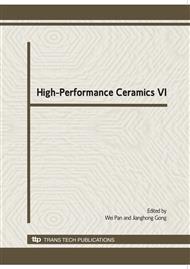p.735
p.739
p.743
p.747
p.751
p.757
p.761
p.764
p.768
Novel Fabrication Method of FGM Containing Nano-Particles - Centrifugal Mixed-Powder Method -
Abstract:
One of the fabrication methods for functionally graded materials (FGMs) is a centrifugal method, which is an application of the centrifugal casting technique. In the method, a centrifugal force applied to a homogeneous molten composite assists the formation of the desired gradation. The compositional gradient is then achieved primarily by the difference in the centrifugal force produced by the difference in density between the molten metal and solid particles. The centrifugal method has the advantage that it is possible to fabricate large size products with low cost. However, disadvantage of the centrifugal method is the difficult for the gradual distribution of small particles. In this study, we proposed a novel fabrication method, centrifugal mixed-powder method, by which we can obtain FGMs containing nano-particle. On first of this processing, powder mixture of functional nano-particle and matrix material is inserted into rotating mold. After that, matrix ingot is melted in crucible and then the melt is poured into the rotating mold with powder mixture. At that time, powder of matrix material is melted by matrix melt poured from crucible. Finally, an FGM ring with functional nano-particles distributed on its surface is obtained. Using this processing method, Al-based FGMs containing TiO2 nano-particles or SiC particles on its surface were fabricated.
Info:
Periodical:
Pages:
751-756
Citation:
Online since:
March 2010
Authors:
Price:
Сopyright:
© 2010 Trans Tech Publications Ltd. All Rights Reserved
Share:
Citation:


